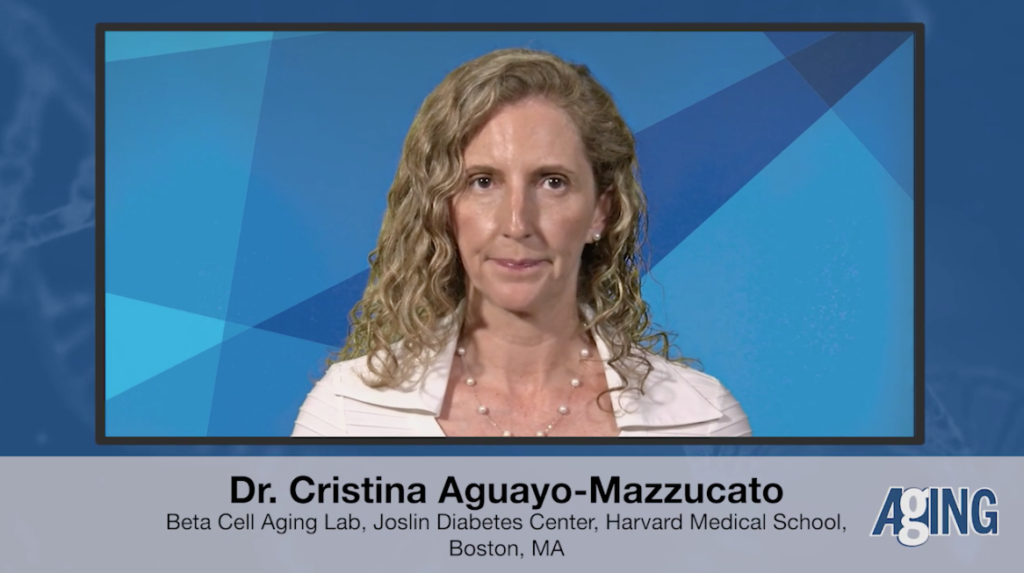Dr. Cristina Aguayo-Mazzucato from Beta Cell Aging Lab, Joslin Diabetes Center, Harvard Medical School, discusses an editorial she co-authored that was published by Aging (Aging-US) in Volume 14, Issue 11, entitled, “Biological age in diabetes and precision medicine.”
Behind the Study is a series of transcribed videos from researchers elaborating on their recent studies published by Aging (Aging-US). Visit the Aging (Aging-US) YouTube channel for more insights from outstanding authors.
—
I am Cristina Aguayo-Mazzucato, assistant professor at Harvard Medical School, assistant investigator at Joslin Diabetes Center, and head of the Beta Cell Aging Lab at Joslin. Today, I will be sharing with you some thoughts about a recent editorial published in Aging entitled, “Biological Aging Diabetes and Precision Medicine.”
In this editorial, we reflect on one of our recent publications showing that people with diabetes have an accelerated biological age compared to their chronological age, which is determined by time of birth. Since biological age reflects the rate of cellular decline, it correlates better with more BDT and mortality. And indeed, we found that individuals with a higher biological age had a greater risk of death in a followup period of 7 years.
We were originally interested in this topic because age is one of the main risk factors to develop type 2 diabetes, and previous research from the lab showed that the development of the disease associates with accelerated aging of insulin-secreting beta cells, specifically through senescence. We wondered whether this accelerated cellular aging in diabetes was also reflected in the whole individual, and more importantly, whether these could be measured with routine clinical biomarkers that were easily accessible during doctor’s visits.
We were surprised and reassured to see that routine clinical biomarkers could be used to calculate biological age, which is a huge step forward in the accessibility of this kind of analysis. We were also surprised to see that as a group, people with pre-diabetes, type 1, and type 2 diabetes all had accelerated biological age, meaning that their cells and tissues age at a faster rate than people without diabetes. However, it became very clear that at an individual level, diabetes was by no means a determinant factor of biological age. This means that among those individuals with diabetes, some had biological age which was younger than their chronological age, while others had an older biological age.
This brings me to my next point, the potential to use these kind of measures to support personalized medicine in the setting of diabetes. It was reassuring to see that even without diabetes, individuals retain different rates of aging. Important follow up questions we have is whether this accelerated aging rate can be altered with either pharmacological or lifestyle interventions. In other words, can accelerated aging be slowed down by a diabetes medications? And if so, is one medication more effective than the other? Another important question is whether exercise, which is so important in the treatment of diabetes, can counteract some of these increased biological age. Another important concept we want to work on is whether the biological age calculated with clinical biomarkers reflects similar acceleration when measured at a DNA methylation level. Important work done by Horvath, Gladyshev, Levine, and Beksly has shown that methylation aging clocks are extremely accurate determining biological age. We would like to perform these studies in a population with diabetes.
Finally, our ultimate hope would be to be able to incorporate the concept of biological age in the routine evaluation and follow up of people with type 2 diabetes. We believe it is a novel parameter that integrates the function of many organs, and it is more accurate than any biomarker by itself in predicting morbidity and mortality. Additionally, we believe it is an additional way to track treatments and interventions.
I would like to acknowledge Nadine Bahour and Briana Cortez from my lab who have spearheaded this project, Hui Pan from the Bioinformatics, Cora Joslyn, who has helped with a lot of the analysis, Alessandro Doria and Hetal Shah for their help analyzing data from the ACCORD trial. Morgan Levine, Danielle Belsky, Steve Horvath, and Vladimir Gladyshev, amongst others, who have laid the foundations of the field, and the Aging journal for their invitation to write the editorial and record this video.
Click here to read the full study published by Aging (Aging-US).
AGING (AGING-US) VIDEOS: YouTube | LabTube | Aging-US.com
—
Aging (Aging-US) is an open-access journal that publishes research papers bi-monthly in all fields of aging research and other topics. These papers are available to read at no cost to readers on Aging-us.com. Open-access journals offer information that has the potential to benefit our societies from the inside out and may be shared with friends, neighbors, colleagues, and other researchers, far and wide.
For media inquiries, please contact [email protected].
